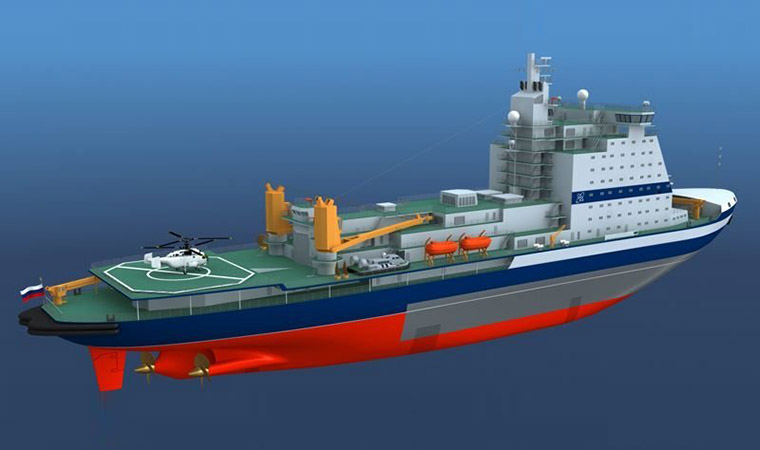
Deep waters calling
back to contentsZiO-Podolsk (a subsidiary of Atomenergomash, Rosatom’s nuclear engineering division) is about to finalize the welding of two halves of the first reactor vessel to be used in the RITM-200 propulsion unit of the new generation Arktika flagship nuclear icebreaker. ZiO-Podolsk engineers have developed a new welding technology never applied before – the final seam is heated up to 200oC during the welding process. Completion of this task will require nearly 600 kg of steel wire, with the seam reaching a thickness of 150 mm. Quality of the welded seam will be controlled after the thermal and mechanical treatment of the reactor vessel.
Simultaneously, the plant manufactures components for the second reactor vessel of RITM-200. They are assisted in this task by OKBM Afrikantov (another subsidiary of Atomenergomash), which produced some parts for the reactor, including the reactor head, a set of pipes and in-vessel components, in August.
Meanwhile, the Baltic Plant in Saint Petersburg finished Arktika’s foreship. Over 70% of the welding has been done by now. In August, shipbuilders finalized the icebreaker’s Section 1101. It is that part of the ship that takes the entire load and breaks ice to make a track. The hull construction has approached its final stage – assembly of the afterbody.
The Arktika flagship nuclear icebreaker will be put afloat in May 2016, says Sergei Chernogubovsky, the Nuclear Icebreaker Project Manager.
“The launch is scheduled for next May, the 160th anniversary of the Plant,” he explains. “We are now finalizing the foreship section and going on with the afterbody. Besides, we are installing fixed ways, tailor-made equipment, service systems, ventilation and air conditioning systems, and doing all the related works. As of today, we have assembled about 170 sections on the stocks, totaling almost 8,000 tons. Almost 20% of the project is completed. It means we move ahead in line with the project schedule.”
According to Sergei Liventsev, Deputy Head of Rosatomflot Representative Office at the Baltic Plant, the shipbuilder meets deadlines, and the customer is satisfied with the work quality. “There are no indications that the commissioning date will be changed. It is but natural that one cannot meet all the deadlines over the five-year horizon, but the final date is fixed.”
New generation icebreakers named Arktika, Sibir (Siberia) and Urals will be capable of traveling through almost three meter thick ice to lead up to 100-ton deadweight ships along the Northern Sea Route. In May, the Baltic Plant started the construction of the Siberia and is to begin the Urals icebreaker in September. Their design allows for the operation in the Arctic deep waters and estuaries of polar rivers. The icebreakers will assist oil tankers and gas carriers in transporting hydrocarbons from the Yamal and Gydan Peninsulas and Kara Sea offshore deposits to the Atlantic and Pacific markets.
Kirov-Energomash (Saint Petersburg, Russia) has designed anti-icing equipment for the new icebreaker. An axial flow compressor, a major component of this equipment, has been manufactured already. Its motor drive capacity is 21 cu m/s, with outlet pressure reaching 2.12 kgf/cm2.
The new compressor is a mix of conventional solutions, advanced electric drive and innovative automation. Its performance was tested on a test installation simulating the icebreaker’s main power systems.
The laying down of the Arktika’s keel took place on 5 November 2013. The icebreaker will be equipped with a new propulsion unit RITM-200 to be manufactured by OKBM Afrikantov. The Arktika will be the largest and the most powerful icebreaker in the world. She will be 173.3 m long and 34 m wide, with a designed draft of 10.5 m and an operating draft of 8.65 m. Displacement will be 33,540 tons. According to the contract, the flagship icebreaker will be completed in December 2017.




